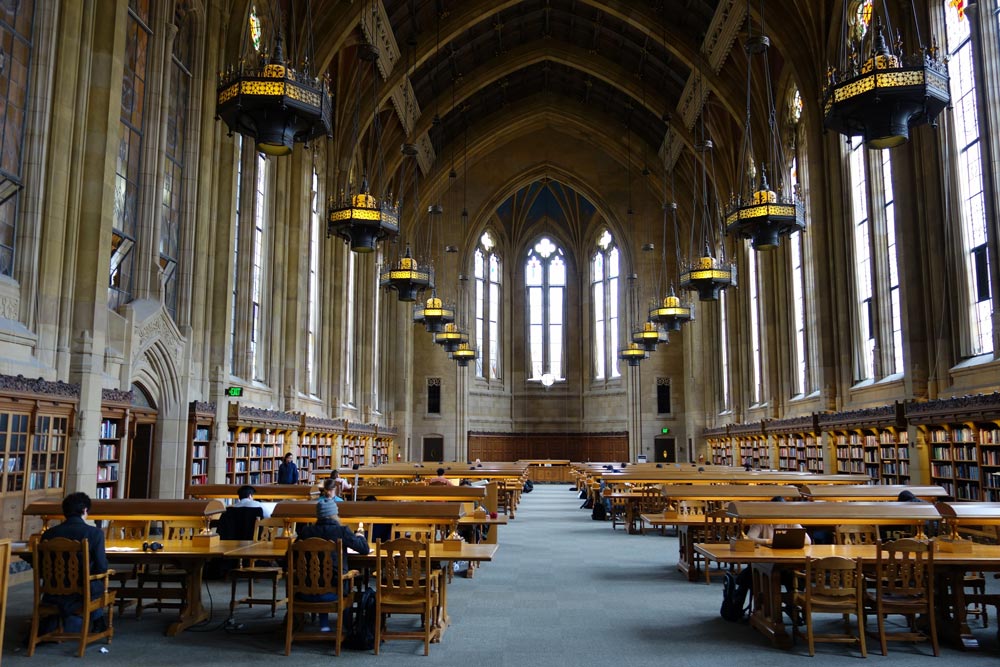
The position of a graduate student worker at an Ivy League or similarly elite private university is unusual. On the one hand, the student worker works in one of the wealthiest institutions in the country. On the other, the benefits of that luxury and wealth fail to reach teaching and research assistants who provide essential labor that allows those elite institutions to function.
The COVID economy has only made this contradiction more vivid. In fact, since the start of the COVID-19 pandemic, Brown, Penn, Yale, Harvard, and Princeton all raked in record returns, raising their endowments by unprecedented rates while refusing raises and downsizing departments. Actions that universities might take to alleviate suffering from the worst effects of pandemic-era inequality—perhaps by raising wages, lowering tuition and fees, or increasing enrollment to more widely distribute their riches—are conspicuous by their absence.
Take Columbia University in New York. Fueled by record stock market gains, Columbia’s endowment soared 32.3 percent between July 2020 and July 2021, with its endowment reportedly $14.35 billion as of June 30, 2021. That’s more than a $3 billion increase in a single year made purely from investments. Meanwhile, until the new collective bargaining agreement—tentatively agreed upon on January 7th—is ratified by the majority of the members and takes effect, many graduate student workers earn a meager $29,000 salary in one of the nation’s most expensive cities. Under the new contract, a press release from the graduate union explains, some workers will receive up to a 30 percent raise.
Columbia and the Student Workers of Columbia (SWC) union have reached a tentative agreement. But the chain of events is telling. Columbia announced its record endowment gain on October 21st. Did it offer to share in this massive fortune, made in a period of extreme social crisis? Not exactly. Instead, the graduate union went on strike on November 3rd—and stayed on strike for over two months—to settle a contract while facing threats of replacement and no backpay.
Columbia students are not alone. Last year, over 7,000 workers at private universities in the Northeast went on strike. In addition to the 3,000-plus workers of Student Workers of Columbia, both the Harvard Graduate Student Union and the Graduate Student Organizing Committee at NYU (New York University) walked off the job. Goals included full union recognition, higher wages, better healthcare, third-party arbitration for discrimination and harassment, parental leave, and protections from government agencies. All three unions are affiliated with the United Auto Workers (UAW), which has long represented graduate student workers at public universities.
The length of the work stoppages has ranged from three days to almost three months, requiring mass participation and mobilizing widespread support from undergraduates, faculty, and other unions across the country. When it ended earlier this month, the SWC-UAW strike at Columbia was the largest strike in the entire country.
Graduate Worker Unions, Then and Now
Graduate employees’ struggle for democratic decision-making at the university did not begin overnight. Unions at public universities date back many decades: student workers at the University of Wisconsin, for example, achieved their first union contract in 1970. But the unionization of student workers in the private sector would take longer, due in large part to legal resistance by their employers.
In 2000, the National Labor Relations Board granted graduate teaching and research assistants at private universities the right to unionize, reversing rules from the mid-1970s that excluded these workers from labor protections. The very next year, graduate student workers from NYU made history by forming a union and negotiating a contract. But by the time graduate students at Brown attempted to do the same in 2004, the Bush administration’s NLRB reversed field and stripped graduate student workers of their collective bargaining rights, and private universities refused to voluntarily recognize unions even where they did form. This remained the case until the 2016 Columbia decision, when the board once again affirmed that graduate student workers at private sector universities had the right to unionize. Since then, graduate students at Brown, Harvard, Georgetown, and elsewhere have successfully won contracts that afford them higher wages, better healthcare, and work protections.
Working Within the Neoliberal University
Universities, as we know, are businesses. Last summer, writing for NPQ, Ira Harkavy and Rita Hodges of the University of Pennsylvania observed that, “Higher education is at least as responsible as any sector for the continued (even if fraying) dominance of a neoliberal economic system.” Even more recently, Davarian Baldwin of Trinity College noted that, “Across America, universities have become today’s companies.”
Sign up for our free newsletters
Subscribe to NPQ's newsletters to have our top stories delivered directly to your inbox.
By signing up, you agree to our privacy policy and terms of use, and to receive messages from NPQ and our partners.
Graduate student workers, like workers in other sectors, have responded accordingly. Their recent strikes and victories point to this newfound political momentum. Increasingly, graduate students have found themselves facing a decimated job market that universities themselves have helped engineer by refusing to grant tenure lines and further casualizing academic labor, with more and more teaching done by adjunct professors who are often paid just a few thousand dollars per course.
Today, almost 75 percent of the academic workforce is untenured, and over half a million jobs have disappeared since the spring of 2020. Prospects of employment have thus only worsened since the start of the pandemic, as many universities—Ivy League-Brown among the first—announced hiring freezes and admissions pauses. This austere landscape has all but destroyed the idea that academia is exempt from the same forces of privatization that plague every other industry in the country, where CEOs and owners collect bonuses while workers stay vulnerable and impoverished. Even at the height of this sectoral crisis, boards of trustees and financial managers at universities have prioritized saving rather than spending, citing long-term sustainability while imposing financial cutbacks.
But there is a cost to this. When institutions don’t take care of their own—when they respond to social chaos and mass death with hiring freezes and budget cuts—workers tend to question why they are risking their lives to continue to do their jobs. Academic workers are no different: growing political consciousness amongst teaching and research assistants is sparked and stoked by the raging inequality, precarity, and artificial scarcity. Facing a lifetime of underemployment in a future mostly devoid of tenure-track jobs, graduate workers are questioning and resisting the longstanding imperative to “pay their dues” or struggle through an advanced degree and amass debt in hopes of security to come. Every time that university administrators refuse workers’ living wage demands, they seed the ground for further dissent.
A Vision for Social Justice
Wages are important, but it’s not all about the money. Although wealthy schools will occasionally make concessions by raising wages and granting benefits, graduate worker unions also address larger issues that impact the communities in which they live and work—a strategy often called “social justice unionism.” This approach to labor organizing attempts to tie fights for better working conditions to larger social concerns, using union resources and political leverage to create change.
For example, NYU GSOC’s contract mandates sanctuary protections from ICE (Immigration and Customs Enforcement) for undocumented students, while Columbia’s tentative agreement secures neutral, third-party arbitration in cases of discrimination and harassment. The members of the Graduate Labor Organization union at Brown University (GLO-AFT), where I serve as the President, just voted to urge the Brown Corporation to divest all funds from companies complicit in human rights abuses in the occupied territories of Palestine and establish a means of oversight over the university’s investments.
Such demands, and others like them, attempt to undo anti-democratic decisions by university administrators and trustees to contract with local police forces, restrict external investigations of abuse, and invest money in companies profiting from political oppression or environmental destruction. Like most large, wealthy corporations, universities fight these efforts towards regulation at every turn. But as the academic labor movement grows, gaining members and contracts, as well as political power, it becomes harder to justify why demands for shared governance or institutional transparency are denied.
Collective action can serve as a check on power abuse and become a vehicle for institutional transformation. But graduate worker unions are only as strong as the rest of the labor movement, which struggles against resistance to regulation and accountability from wealthy businesses across industries. An Economic Policy Institute report recently found that corporations in the United States spend $340 million a year on union-busting lawyers and consultants to resist granting workers collective bargaining rights or to limit the scope of union power.
Private universities follow this corporate playbook. Harvard University’s administration, for example, insists on undermining union security by keeping the university “open shop”— that is, on keeping graduate union membership optional, making it harder for the union to sustain itself.
Although the members of Harvard’s graduate union went on a three day strike this year, hoping in part to rid themselves of this arrangement, they were not able to secure this in their contract. Even though every other employee union at Harvard enjoys this provision, the administration seems intent on keeping HGSU separate. Harvard’s efforts don’t exist in a vacuum: right-to-work laws currently similarly restrict unions in 27 states. When they take on these issues at their own universities, graduate student workers are engaging in wider struggle against the national repression of organized labor.
Despite such obstacles, graduate student workers at private universities have made many strides, organizing against top-down governance and towards financial transparency. Private higher education faces multiple pressures—including rising debt, soaring tuition, increased sectoral unemployment, and often a bloated administration. And for the time being, private universities cannot function without graduate student labor. In this turbulent world, graduate student workers may be uniquely situated to beat back the descent into corporatization—perhaps even to push private universities to reclaim their mission as democratic institutions for public good.










